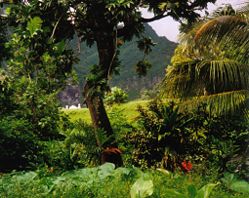Natural resource

Natural resources are naturally occurring substances that are considered valuable in their relatively unmodified (natural) form. A natural resource's value rests in the amount and extractability of the material available and the demand for it. The latter is determined by its usefulness to production. A commodity is generally considered a natural resource when the primary activities associated with it are extraction and purification, as opposed to creation. Thus, mining, petroleum extraction, fishing, hunting, and forestry are generally considered natural-resource industries, while agriculture is not. The term was introduced to a broad audience by E. F. Schumacher in his 1970s book Small is Beautiful.[1] The term is defined in the United States by the United States Geological Survey as "The Nation's natural resources include its minerals, energy, land, water, and biota."[2]
Contents |
Classification of natural forms
Natural resources are mostly classified into renewable and non-renewable resources. Sometimes resources are classified as non-renewable even if they are technically renewable, just not easily renewed within a reasonable amount of time.
Renewable resources
Renewable resources are sometimes living resources (trees and soil, for example), which can restock (renew) themselves if they are not over-harvested but used sustainably. There are also non-living resources that are renewable, such as hydroelectric power, solar power, biomass fuel, and wind power. Once renewable resources are consumed at a rate that exceeds their natural rate of replacement, the standing stock (see renewable energy) will diminish and eventually run out. The rate of sustainable use of a renewable resource is determined by the replacement rate and amount of standing stock of that particular resource. Non-living renewable natural resources include dirt and water.
Flow renewable resources are very much like renewable resources, only they do not need regeneration, unlike renewable resources. Flow renewable resources include renewable energy sources such as the following renewable power sources: solar, geothermal, landfill gas, tides and wind.
Resources can also be classified on the basis of their origin as biotic and abiotic. Biotic resources are derived from living organisms. Abiotic resources are derived from the non-living world (e.g., land, water, and air). Mineral and power resources are also abiotic resources some of which are derived from nature.
Non-renewable resources
A non-renewable resource is a natural resource that exists in a fixed amount that cannot be re-made, re-grown or regenerated as fast as it is consumed and used up.[3]
Some non-renewable resources can be renewable but take an extremely long time to renew. Fossil fuels, for example, take millions of years to form and so are not practically considered 'renewable'. Different non-renewable resources like oil, coal, natural gas etc. have different levels of demand from different sectors like transportation and residences with each resource specializing for each sector.[4] Many environmentalists proposed to tax on consumption of non renewable resources. NON-renewable resources can not be replaced.
Natural capital
Natural resources are natural capital converted to commodity inputs to infrastructural capital processes.[5][6] They include soil, timber, oil, minerals, and other goods taken more or less from the Earth. Both extraction of the basic resource and refining it into a purer, directly usable form, (e.g., metals, refined oils) are generally considered natural-resource activities, even though the latter may not necessarily occur near the former. This process generates high profits due to the high demand for the natural resources and the energies that they are able to generate.
A nation's natural resources often determine its wealth in the world economic system and its diplomatic, military, and political influence. Developed nations are those which are less dependent on natural resources for wealth, due to their greater reliance on infrastructural capital for production. However, some see a resource curse whereby easily obtainable natural resources could actually hurt the prospects of a national economy by fostering political corruption. Political corruption can negatively impact the national economy because time is spent giving bribes or other economically unproductive acts instead of the generation of generative economic activity. This has been seen over the years with legislation passed to appease companies who will benefit. There also tends to be concentrations of ownership over specific plots of land that have proven to yield natural resources.
In recent years, the depletion of natural capital and attempts to move to sustainable development have been a major focus of development agencies. This is of particular concern in rainforest regions, which hold most of the Earth's natural biodiversity - irreplaceable genetic natural capital. Conservation of natural resources is the major focus of natural capitalism, environmentalism, the ecology movement, and green politics. Some view this depletion as a major source of social unrest and conflicts in developing nations.
Other information sources
- Natural Resources Weblinks (University of Denver )
See also
|
|
References
- ↑ E.F. Schumacher, Small Is Beautiful, Hartley & Marks Publishers, December 1999. ISBN 0-88178-169-5
- ↑ "Natural Resources". U.S. Geological Survey. Retrieved on 2008-10-09.
- ↑ Terminology Reference System, Non-renewable resource from the website of the U.S. Environmental Protection Agency
- ↑ Chakravorty, Ujjayant, Darrell Krulce, and James Roumasset. "Specialization and non-renewable resources: Ricardo meets Ricardo." Journal of Economic Dynamics & Control 29.9 (Sept 2005): 1517(29). Expanded Academic ASAP. Gale. University of Washington. 3 Nov. 2008
- ↑ Quentin Grafton and Robert Hill (University of New South Wales and W. Adamowicz, Diane Dupont, S Renzetti and Harry Nelson (University of British Columbia (2004). The Economics of the Environment and Natural Resources. Blackwell Punlishing. ISBN 0631215646.
- ↑ A.Weintraub, C. Romero, T. Bjørndal, and R. Epstein (Editors) (2007). Handbook of Operations Research in Natural Resources. Springer. ISBN 0-387-71814-9.
External links
- Statistics on natural resources in Canada
- Wind power dilemma for Lewis a BBC News article about an island in the Hebrides